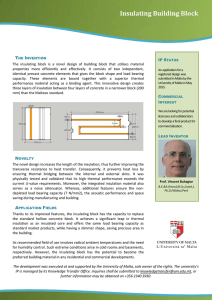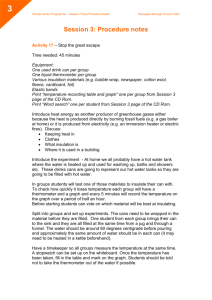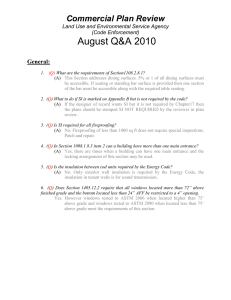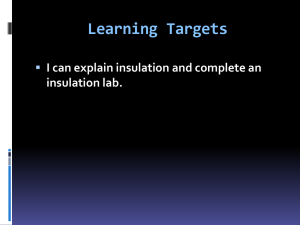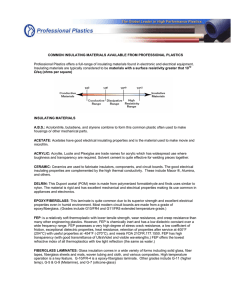C-10 Insulation Preventing Conduction
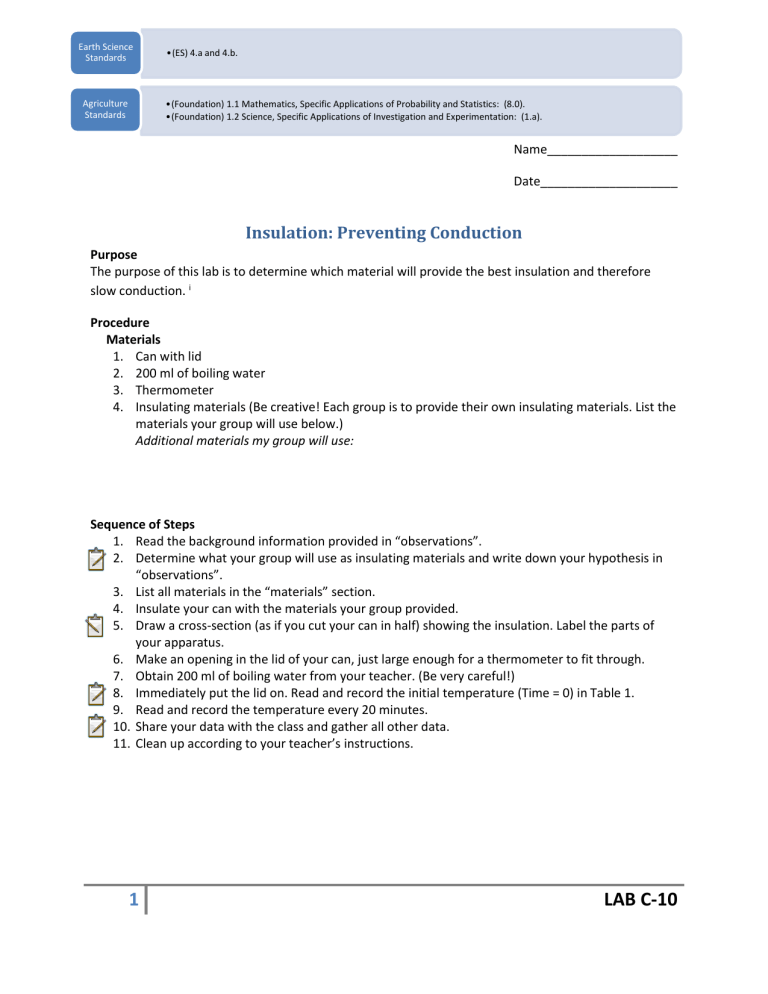
Earth Science
Standards
•(ES) 4.a and 4.b.
Agriculture
Standards
•(Foundation) 1.1 Mathematics, Specific Applications of Probability and Statistics: (8.0).
•(Foundation) 1.2 Science, Specific Applications of Investigation and Experimentation: (1.a).
Name___________________
Date____________________
Insulation: Preventing Conduction
Purpose
The purpose of this lab is to determine which material will provide the best insulation and therefore slow conduction. i
Procedure
Materials
1.
Can with lid
2.
200 ml of boiling water
3.
Thermometer
4.
Insulating materials (Be creative! Each group is to provide their own insulating materials. List the materials your group will use below.)
Additional materials my group will use:
Sequence of Steps
1.
Read the background information provided in “observations”.
2.
Determine what your group will use as insulating materials and write down your hypothesis in
“observations”.
3.
List all materials in the “materials” section.
4.
Insulate your can with the materials your group provided.
5.
Draw a cross-section (as if you cut your can in half) showing the insulation. Label the parts of your apparatus.
6.
Make an opening in the lid of your can, just large enough for a thermometer to fit through.
7.
Obtain 200 ml of boiling water from your teacher. (Be very careful!)
8.
Immediately put the lid on. Read and record the initial temperature (Time = 0) in Table 1.
9.
Read and record the temperature every 20 minutes.
10.
Share your data with the class and gather all other data.
11.
Clean up according to your teacher’s instructions.
1 LAB C-10
Observations
Background Information: Energy always flows from areas of higher energy to areas of lower energy. In terms of heat, this means that energy will flow from hotter areas to cooler areas.
This occurs any time there is a temperature difference. The greater the temperature difference, the faster conduction will occur to equalize temperatures.
Some materials allow thermal energy to flow freely from hot to cold. These materials are called conductors. Metals are generally very good conductors, which is why we use metals for pots and pans. Materials that slow conduction are called insulators. In general, the less dense something is (the more air spaces there are), the better insulator it is because trapped air
(where there is no air exchange) is one of the best insulators around. Plastic, foam, and air trapped between two panes of glass (dual pane windows) are some of the best insulators.
1.
Hypothesis: If an insulator is made using ________________________________________, then the flow of thermal energy will be minimized.
2.
Draw a cross section of your can showing the insulation. Label all components.
2 LAB C-10
5
6
7
8
9
10
11
12
13
14
15
16
17
18
19
20
Table 1. Water temperatures over time in a comparison of insulating materials.
Group Group Group Group Group Group Group
1 2 3 4 5 6 7
Primary
Insulating
Material
Time
(min)
Temperature ( o C)
0
1
2
3
4
Group
8
3 LAB C-10
Construct a line graph showing the temperature change for each set up. Write a tile on your graph.
Place Time (min) on the x-axis and Temperature ( o C) on the y-axis. Use a different color for each line and make a key indicating which line corresponds to which group. Draw all lines using a ruler. Make your graph neat and complete.
4 LAB C-10
ANALYSIS: (Answer using complete sentences and actual data.)
1.
Calculate the temperature change for each group. Show your work.
(Temperature Change = final temperature – initial temperature --- ΔT = T f
– T i
)
Group 1
Group 2
Group 3
Group 4
Group 5
Group 6
Group 7
Group 8
2.
Which group’s set up had the least temperature change? Explain how you determined this
(compare insulation to that of the other groups).
3.
If you were going to build a home, explain the characteristics of the insulation you would you use to make sure it was as energy efficient as possible? Explain why.
4.
Brainstorm at least 3 aspects of production agriculture which rely on insulation for the quality of their product.
5.
What agricultural products and/or byproducts could be used for insulation? i
Looper, Jim (2008). Insulation: Preventing Conduction, Lab. Sheldon High School Science Dept.
5 LAB C-10
